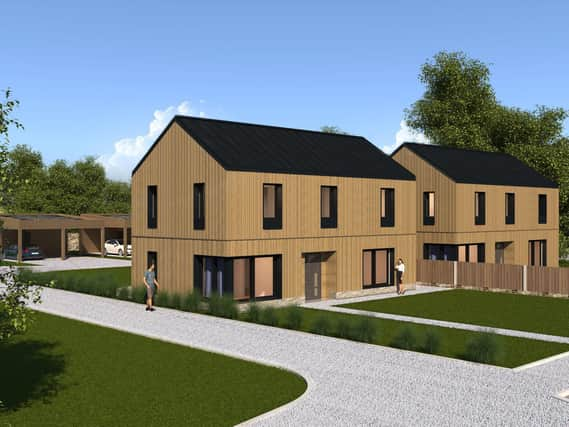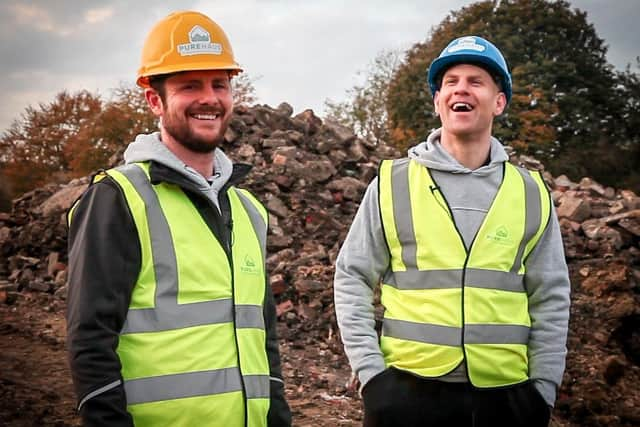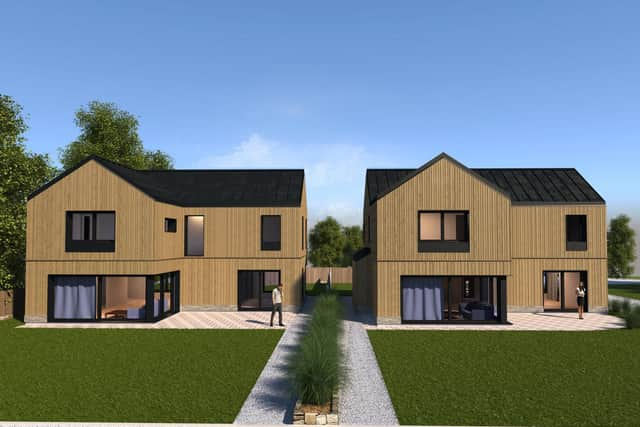Yorkshire developer building Passivhaus homes that need no heating


It would have been quicker, easier and less expensive to build bog-standard new-builds on the semi-derelict site on Sugden Street, in Oakenshaw village, near Bradford. But it wouldn’t have been interesting or exciting, which is why David Bradley-Bowles and Kevin Pratt decided to do something different.
The pair, who trade as Pure Haus, took the view that nothing worth having comes easy and are constructing two ‘Passivhaus’ properties on the semi-rural plot.
Advertisement
Hide AdAdvertisement
Hide AdThe contemporary five-bedroom homes at Pure Meadows are now on the market for £600,000 each and will be sustainable and supremely energy efficient.


Passivhaus is the world’s leading low energy design standard that reduces heat demand on a home. As a result, they are low carbon and good for the planet, cost barely anything to run and have a host of health benefits. Most Passivhaus homes have little or no heating. It’s not unusual for them to have just a single radiator.
The design method originated in Germany in the 1990s after a group of academics formalised and updated techniques that people have been using for centuries, such as insulating to high levels and positioning homes for solar gain to maximise natural warmth from the sun.
The three cornerstones of Passivhaus are high levels of insulation that far surpass those required by building regulations, ensuring that a building is airtight and use of a mechanical heat and ventilation system. The MHVR unit extracts warm, damp air from the home and draws in fresh air from outside. The warm, extracted air is passed through a heat exchanger to recover the heat. The cool, fresh air is also passed through the heat exchanger, where it is warmed before being pumped into the property. A filtration system to eliminate pollutants and irritants, such as pollen, dust and harmful particulates.
Advertisement
Hide AdAdvertisement
Hide AdThe biggest challenge with Passivhaus construction is ensuring airtightness, which means no thermal bridging, the tiny gaps that bring draughts.


In most homes, including new-builds, these gaps are around the roof, the window and door frames and around pipework, cabling and sockets. This strict attention to detail brings extra build costs of about 20 per cent.
However, the property’s running costs are drastically reduced, which means long-term gains for homeowners. According to the UK’s Passivhaus Trust, which aims to promote the benefits of the building method in the UK, Passivhaus buildings achieve a 75 per cent reduction in space heating requirements, compared to a standard new-build.
The plan is for Pure Haus to scale up their operation and lead the way in creating small developments of Passivhaus properties. At the moment, most are on single plots by self-builders, as most volume builders shun them because they are more costly to construct and require exceptional attention to detail.
Advertisement
Hide AdAdvertisement
Hide AdHuddersfield-based The Green Building Company, the construction division of Green Building Store, helped pioneer the Passivhaus building method in Britain. The first house built by the firm, headed by Bill Butcher and Chris Herring, was for a client in Denby Dale. It was the first Passivhaus in the UK with a cavity wall.
The company also built a contemporary Passivhaus in Golcar and used the low energy building techniques to convert a derelict cow byre into an education centre for the Yorkshire Wildlife Trust. The owners of the Golcar house say: “It is an incredibly comfortable house with a constant temperature throughout. We’ve only got two radiators in the whole place, which we rarely use, so the fuel bills are 90 per cent less than our old 1930s house. It is also very tranquil because of the insulation and triple glazing and it feels so much healthier because of the filtered air.”
The Pure Haus ambition to create small developments of the energy-efficient, low-impact homes began after David Bradley-Bowles attended a Passivhaus conference in Germany.
“He came back very excited and we began to explore whether we could adopt it and take it further and do developments,” says Kevin. “We really believe it is the way forward.”
Advertisement
Hide AdAdvertisement
Hide AdThe pair are also property investors with a long track record of major renovations and conversions who were keen to diversify into construction.
“We looked at the traditional model but felt it wasn’t going to be very fulfilling, which is why we took a different approach,” says Kevin.
The properties at Pure Meadows will be Passivhaus standard with a timber frame and Ecobead, expanding foam insulation. They are clad in stone and Siberian larch with a corrugated steel roof. They will both have a rainwater harvesting system and an MVHR unit plus electricity generating photovoltaic panels on the garage roof.
While they are priced at up to 20 per cent more than a standard new home of the same size, the cost benefit analysis stacks up.
Advertisement
Hide AdAdvertisement
Hide Ad“Not only are they healthier, more comfortable and better for the environment, they are much cheaper to run so there is a return on the investment. The average house this size costs £1,600 a year to run and ours will be about £320,” says Kevin, who adds: “We love to do is scale this up and eventually build Passivhaus homes at the bottom end of the market where fuel poverty is a real issue. That would be satisfying. This isn’t just about the bottom line, it’s about creating a legacy.”
*The Pure Haus Passivhaus homes have five bedrooms and are on the market for £600,000 each with Hamilton Bower estate agents.
They are on Sugden Street in the village of Oakenshaw, which is four miles from Bradford and 11 miles from Leeds with easy access to the M606 and M62. www.hamiltonbower.co.uk; www.purehaus.co.uk *The Green Building Company offers Passivhaus training and consultancy, greenbuildingstore.co.uk
*Editor’s note: first and foremost - and rarely have I written down these words with more sincerity - I hope this finds you well.
Advertisement
Hide AdAdvertisement
Hide AdAlmost certainly you are here because you value the quality and the integrity of the journalism produced by The Yorkshire Post’s journalists - almost all of which live alongside you in Yorkshire, spending the wages they earn with Yorkshire businesses - who last year took this title to the industry watchdog’s Most Trusted Newspaper in Britain accolade.
And that is why I must make an urgent request of you: as advertising revenue declines, your support becomes evermore crucial to the maintenance of the journalistic standards expected of The Yorkshire Post. If you can, safely, please buy a paper or take up a subscription. We want to continue to make you proud of Yorkshire’s National Newspaper but we are going to need your help.
Postal subscription copies can be ordered by calling 0330 4030066 or by emailing subscriptions@jpimedia.co.uk. Vouchers, to be exchanged at retail sales outlets - our newsagents need you, too - can be subscribed to by contacting subscriptions on 0330 1235950 or by visiting www.localsubsplus.co.uk where you should select The Yorkshire Post from the list of titles available.
If you want to help right now, download our tablet app from the App / Play Stores. Every contribution you make helps to provide this county with the best regional journalism in the country.
Sincerely. Thank you.
James Mitchinson
Editor